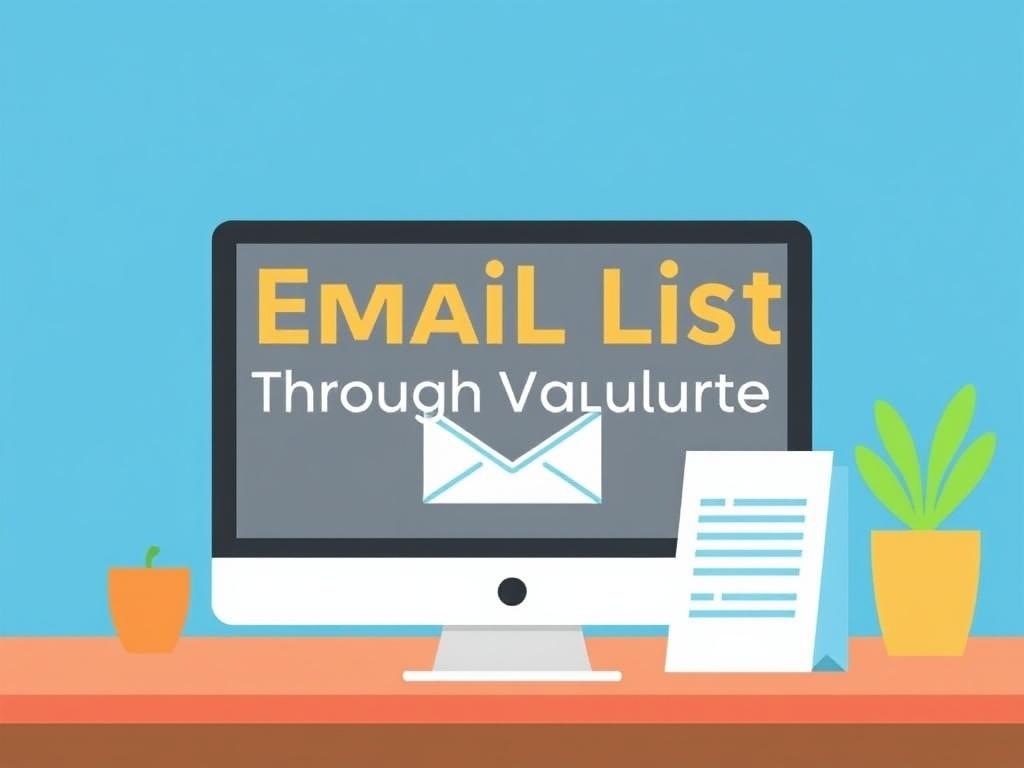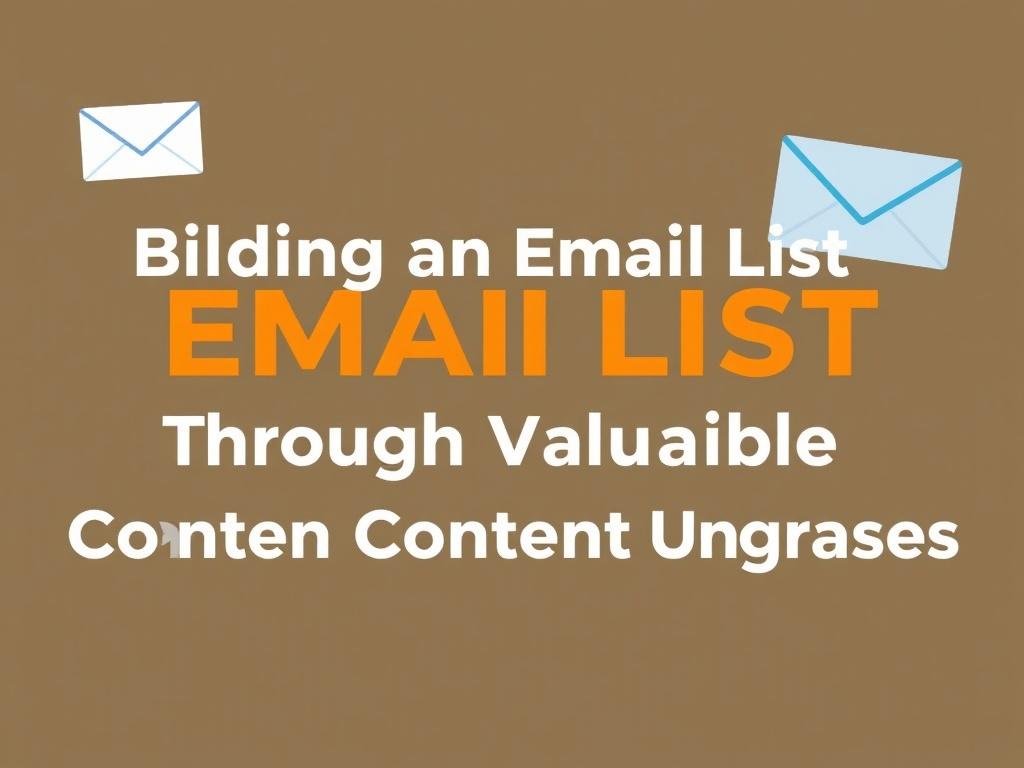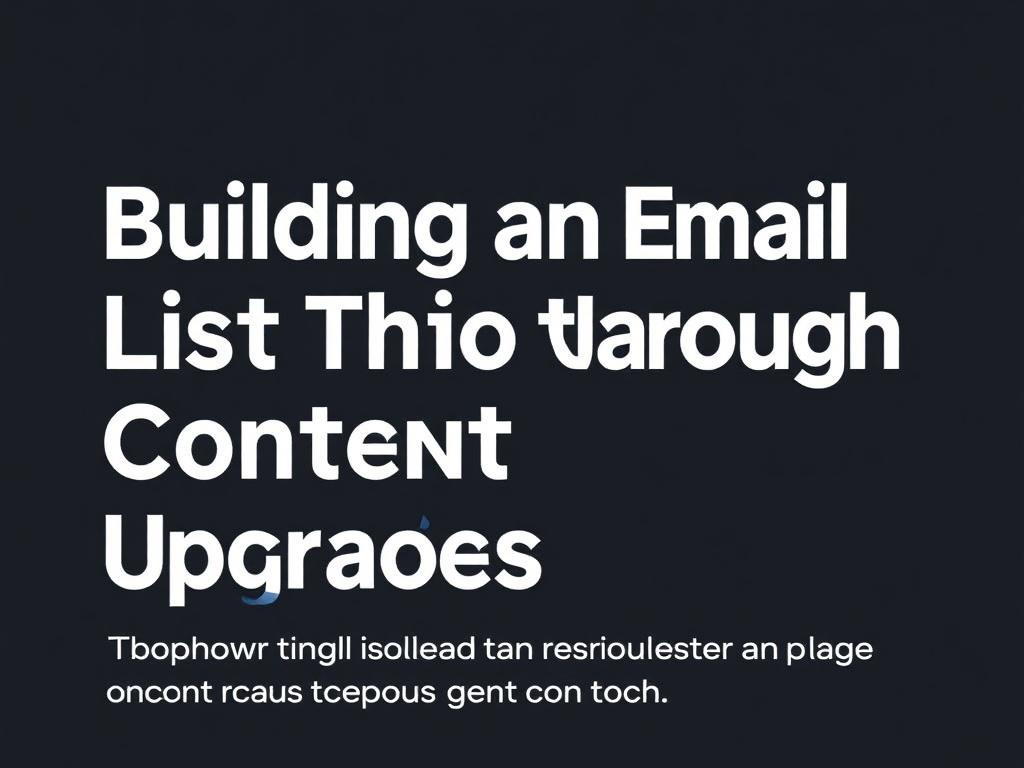If you’ve ever wondered why some websites seem to collect email subscribers like bees to honey, the secret is often a smart content upgrade. Not a flashy giveaway that screams “subscribe now,” but a genuinely useful add-on that follows the content your reader is already consuming. In this article I’m going to walk you through why content upgrades work, the types that convert best, and a step-by-step process for creating them so readers happily trade their email for real value. No jargon-heavy lectures — just practical, clear steps you can use today.
Think of a content upgrade as a friendly, relevant offer that sits right next to the thing your visitor is reading. It’s not a one-size-fits-all lead magnet; it’s targeted, bite-sized, and directly tied to a specific post or page. When a reader feels like they’re getting something that enhances what they just learned, they’re far more likely to opt in. That simple idea — matching value to context — is the foundation of building an email list that’s engaged and eager to hear from you again.
What Exactly Is a Content Upgrade?
A content upgrade is a focused, relevant add-on offered inside or alongside a blog post or page. Unlike general lead magnets (like “Download our free ebook”), content upgrades are tailored to a specific piece of content. If your article is “10 Ways to Improve Sleep,” a content upgrade could be a printable sleep tracker that directly helps readers apply the tips in the post. It’s context-aware, actionable, and easy for readers to use immediately.
Content upgrades are powerful because they increase perceived value. When an upgrade feels personalized to the user’s current needs, it not only boosts conversion but attracts higher-quality subscribers — the kind who actually engage with your email marketing.
How a Content Upgrade Differs From a Lead Magnet
General lead magnets aim for broad appeal. Content upgrades aim for immediate relevance.
- Lead magnet: “Get our ultimate marketing ebook.” Large, generic, lower conversion on specific posts.
- Content upgrade: “Grab the 1-week content calendar used in this post.” Relevant, specific, higher conversion on that post.
The lesson is simple: targeted relevance beats broad appeal when your goal is to grow an engaged email list quickly.
Why Content Upgrades Work: The Psychology and the Practicality
Imagine reading a helpful article and then seeing an offer for a tool or checklist that makes implementing that article’s tips easier. That feels like a natural next step. Content upgrades tap into a few psychological triggers:
- Immediate relevance — The upgrade is tied to something you’re already invested in.
- Reciprocity — You’ve received useful content; you feel comfortable giving your email in return for additional value.
- Ease of implementation — Upgrades that help you act now beat long, vague freebies.
From a practical standpoint, content upgrades are easy to create and easy to A/B test. They allow you to monetize existing traffic more effectively by converting passive readers into subscribers. And because they’re specific, conversion rates tend to be significantly higher than generic opt-ins.
Types of Content Upgrades That Convert
There are many ways to give readers extra value. Below is a table that shows common content upgrade types and when to use them.
| Type | Best Use | Quick Example |
|---|---|---|
| Checklist | How-to posts, tutorials | “Print this 10-step checklist for launching an email campaign” |
| Template | Business, design, writing templates | “Download the invoice template used in this post” |
| Worksheet/Worksheet Pack | Planning, strategy, personal development | “Use this budget worksheet to follow along” |
| Short Guide or Mini ebook | In-depth tutorials that need a separate resource | “15-minute SEO checklist PDF” |
| Video or Screencast | Technical tutorials, demos | “Watch the 10-minute walkthrough of this plugin” |
| Spreadsheets/Calculators | Finance, marketing metrics | “Download the ROI calculator used in this article” |
| Resource List | Roundups and recommendation posts | “Complete list of tools with links and pricing” |
| Bonus Chapter or Case Study | Long-form content and case studies | “See the full case study with results” |
This table is just a starting point. The best content upgrades solve a narrow problem, are quick to consume, and help the reader take immediate action.
Examples of High-Converting Content Upgrades
- Blog post: “How to Write a Resume.” Upgrade: Resume template + 3 fill-in-the-blank examples.
- Blog post: “10 Social Media Post Ideas.” Upgrade: 30-day content calendar in Google Sheets.
- Tutorial: “Build a Landing Page.” Upgrade: Landing page swipe files and a checklist for launch.
Each example directly extends the main content and makes it easier for the reader to apply the advice.
Step-by-Step: Creating a Content Upgrade That Grows Your Email List

Creating a content upgrade can be boiled down to a reliable process. Follow these steps and you’ll produce upgrades that convert.
Step 1 — Audit Your Existing Content
Start by finding posts that already generate traffic. These are low-hanging fruit for content upgrades.
- Use Google Analytics or your CMS analytics to identify high-traffic posts.
- Look for posts with strong organic search volume, social shares, or time-on-page.
- Prioritize posts that naturally lend themselves to an actionable add-on.
The idea is to add upgrades to posts that already have traffic. Converting existing visitors is faster and cheaper than creating new traffic.
Step 2 — Identify a Narrow, Actionable Need
Ask: what’s the next logical action a reader would take after consuming this post? That’s your upgrade.
- Example: If the post is about “meal prep on a budget,” the upgrade could be a weekly shopping list or a printable meal plan.
- Keep it simple and directly useful — avoid vague or generic add-ons.
Narrow upgrades are more appealing than generic freebies because they feel crafted for the immediate problem.
Step 3 — Choose the Right Format
Pick one of the types above based on how the reader will use the upgrade.
- Make checklists or templates downloadable as PDFs for easy printing or saving.
- Use Google Sheets or Excel files for calculators and calendars to make them interactive.
- Record short videos for walkthroughs that need visual explanation.
The format should match the content. A template can’t replace a calculator, and a long ebook won’t help if a quick checklist would do.
Step 4 — Create the Content Upgrade Quickly and Well
You don’t need a huge marketing budget. Use simple tools:
- Google Docs or Canva for PDFs and worksheets
- Google Sheets for calculators
- Loom or your phone camera for quick demo videos
Keep design clean, brand it, and add clear instructions so subscribers can use the upgrade immediately.
Step 5 — Add a Strong, Contextual Call to Action
Write a short opt-in that fits the post. Avoid generic copy like “Join our newsletter.” Instead, say what they’ll get, how it relates to the post, and how long it takes to use.
Example CTA for a post about time blocking:
“Get the 7-day time-blocking template to plan your week in 15 minutes — download the Google Sheet now.”
Place the CTA in multiple locations: at the top feature box, mid-post inline, and at the end. Use an eye-catching button and a small visual of the upgrade.
Step 6 — Create a Simple Delivery Mechanism
You want a fast, reliable opt-in flow:
- Use your email service provider (ESP) to create a single-field opt-in (name optional, email required).
- Deliver the content instantly via a confirmation email or redirect to a download page after sign-up.
- Consider direct download (no double opt-in) for the fastest access, depending on your ESP and compliance requirements.
Make sure the download link or email arrives immediately — delay kills conversions and trust.
Step 7 — Automate a Welcome Sequence
Treat the content upgrade as the start of a relationship, not a one-off transaction.
- Set up a short 3–5 email welcome series that delivers the upgrade, explains how to use it, and offers next steps.
- Send a follow-up email a few days later asking how the upgrade worked and offering additional help or resources.
- Use tags or segments so you know which upgrade a subscriber used and can tailor future messages.
Automation keeps the new subscriber engaged and increases the chance they’ll open future emails.
Placement and Design: Where and How to Offer Upgrades
The placement of your content upgrade matters. Here are effective placements and design tips.
Best Placements
- Top-of-post feature box: For visitors who are scanning and want quick value.
- Inline mid-article: When the upgrade matches the part of the post where readers need help.
- End of post: For readers who finish and want more tools or next steps.
- Exit-intent or slide-in: Use sparingly and only when it matches user intent.
Design Tips
- Use a compact, non-intrusive box with a clear headline and one-sentence benefit.
- Include an image of the PDF or a short list of what’s inside.
- Use contrasting colors for the CTA button but keep it on-brand.
- Keep the opt-in form to one field when possible — the fewer fields, the higher the conversion.
Small changes in phrasing, button color, or placement can significantly alter conversion rates, so test.
How to Promote Your Content Upgrade Beyond the Post
Don’t rely only on organic traffic to the post. Use these promotion channels to drive more targeted visitors who are likely to opt in.
- Related blog posts: Add contextual links to the upgrade on other pages that discuss related topics.
- Social posts: Tease the upgrade with a short snippet or image and link to the article landing page.
- Paid ads: Use highly-targeted ads pointing to the post with the upgrade (cost-effective if conversion rate is high).
- Email: Send the post to your existing list and mention the upgrade as an exclusive bonus for subscribers.
- Partnerships: Cross-promote with other creators in your niche who can drive qualified traffic.
Focus promotions on audiences who are most likely to find the upgrade relevant — relevance is the key to conversion.
Measure What Matters: Metrics to Track
To know whether your content upgrade strategy is working, track a few essential metrics. Here’s a quick table of what to watch and why it matters.
| Metric | Why It Matters | Target/Goal |
|---|---|---|
| Opt-in conversion rate (per post) | Tells you how effectively the upgrade converts the traffic for that post | 5–25%+ is feasible depending on intent |
| Subscriber quality (open & click rates) | Shows whether subscribers are engaged or just signing up for freebies | Open rates above your baseline for list; higher is better |
| Traffic to upgraded posts | Shows how many potential conversions you can get | Steady or growing over time |
| Unsubscribe rate | Checks whether your upgrade is attracting the right audience | Lower than general list unsubscribe rate |
| Sales or goal conversions from new subscribers | Measures long-term value of subscribers from upgrades | Depends on business model; this is the ultimate ROI metric |
Segment your analytics by upgrade so you can compare which offers produce the most valuable subscribers.
A/B Testing Content Upgrades: Quick Experiments That Pay Off
A/B testing helps you optimize far faster than guessing. Here are a few simple split tests that yield clear results:
- Headline of the CTA box (benefit-focused vs. curiosity-focused)
- Button text (e.g., “Get the Checklist” vs. “Download Now”)
- Form fields (email only vs. email + name)
- Placement (top vs. mid-post vs. end)
- Format (PDF vs. Google Sheet vs. video)
Run one test at a time, collect enough data, and then implement the winner. Small percentage improvements compound quickly across many posts.
List of Content Upgrade Ideas by Niche

If you’re stuck for ideas, here’s a straightforward list of content upgrade ideas across popular niches.
| Niche | Content Upgrade Ideas |
|---|---|
| Health & Fitness | Meal plan PDFs, workout demo videos, calorie calculators, habit trackers |
| Personal Finance | Budget spreadsheets, bill-pay checklists, saving challenge plans |
| Marketing & Business | Social media calendars, email swipe files, marketing plan templates |
| Education & eLearning | Lesson plan templates, study schedules, downloadable summaries, flashcards |
| Design & Creative | Design mockups, font pairing guides, project briefs, source files |
| Technology & Development | Code snippets, cheat sheets, setup scripts, short how-to videos |
These ideas are practical and quick to make — pick the one that matches the main topic and build it fast.
Common Mistakes and How to Avoid Them
Even well-meaning attempts at content upgrades can fall flat. Here are mistakes I see often and how to fix them.
- Too generic: Fix by tying the upgrade tightly to the article’s specific problem.
- Overly long: Keep upgrades short and actionable so readers can use them right away.
- Poor delivery: Ensure the download works and arrives instantly — test the flow yourself.
- Bad placement: Don’t bury the upgrade where readers won’t see it; use multiple placements.
- No follow-up: Follow up automatically to help people use the upgrade and stay engaged.
Avoid these mistakes and you’ll see measurable improvements in conversion and subscriber quality.
Tools and Resources to Make Content Upgrades Faster

You don’t need an expensive stack to implement content upgrades. Here’s a compact list of useful tools.
- Design & PDFs: Canva, Google Docs
- Spreadsheets: Google Sheets, Excel
- Video recording: Loom, QuickTime, smartphone camera
- Email & Opt-ins: Mailchimp, ConvertKit, ActiveCampaign, MailerLite
- Popup/Inline Forms: Elementor, OptinMonster, Sumo, Thrive Leads
- File delivery: Amazon S3, Dropbox, Google Drive, your ESP’s download feature
Pick whatever integrates with your website and ESP and keep things simple. Complexity kills momentum.
Case Study: How a Small Blog Doubled Its List with Content Upgrades
Let me tell you a simple, realistic case. A small blog on personal productivity had decent traffic but a low email signup rate. They audited their top five posts and created a unique content upgrade for each: a printable planner, a 14-day habit tracker, a 7-day email course, and two downloadable templates. They used a compact opt-in form and a one-click download link in the confirmation email.
Within three months:
- Conversion rates on upgraded posts went from 1.5% to 14% on average.
- New subscriber open rates were 10–20% higher than their general list.
- Subscriber quality improved, leading to better engagement and eventual product purchases.
The key was relevance and speed: the upgrades matched the posts and required only a few minutes to use.
Scaling Your Content Upgrade Strategy
Once you’ve proven content upgrades work, scale gradually:
- Systematize creation with templates so you don’t recreate the wheel for every post.
- Focus on top-traffic posts first to maximize ROI.
- Use tagging in your ESP to know which upgrade each subscriber used.
- Repurpose upgrades: turn a PDF into a short video, or a spreadsheet into a Google Sheet template.
Avoid trying to upgrade every single post at once. Prioritize and iterate.
How to Turn Content Upgrade Subscribers Into Loyal Customers
New subscribers are valuable, but they become loyal customers when you nurture them properly.
- Send a warm welcome immediately and tell them how to use the upgrade.
- Deliver consistent value in subsequent emails — education, stories, and useful tips.
- Introduce offers only after building trust and demonstrating value.
- Segment subscribers by upgrade to send more relevant offers later.
This approach increases lifetime value and reduces unsubscribes because every email earns credibility.
Follow-up Sequence Example
Here’s a short 4-email sequence you can adapt:
- Email 1 (Immediate): Deliver the upgrade and a short note on how to use it.
- Email 2 (Day 2): Quick tip or example using the upgrade in real life.
- Email 3 (Day 5): Ask a question or invite feedback — encourage replies.
- Email 4 (Day 10): Offer a deeper resource or relevant product, framed as help, not a hard sell.
This sequence builds trust and primes subscribers for future offers.
Legal and Privacy Considerations
Even a simple content upgrade requires attention to privacy and compliance:
- Make sure you comply with GDPR and other local regulations if you collect emails globally.
- Provide a clear privacy policy and link to it on the opt-in form.
- Consider double opt-in if your ESP or target region prefers it, but know it can reduce initial conversions.
Transparency builds trust. Tell subscribers what they’ll receive and how often.
Final Tips: Little Things That Make a Big Difference
A few practical tips that top performers use:
- Use social proof near your upgrade: “Join 2,500 readers who downloaded this template.”
- Show a preview of the upgrade (two sample pages) to reduce friction.
- Keep file sizes small for faster downloads and mobile-friendly access.
- Regularly update upgrades so they stay relevant and accurate.
- Repurpose upgrades into gated content for webinars or paid products later on.
Small, thoughtful details often yield outsized returns.
Conclusion
Content upgrades are one of the simplest, most effective ways to grow a high-quality email list because they deliver targeted, immediate value tied to what your reader is already consuming. Start by auditing your most-trafficked posts, pick a narrow actionable need, create a short, well-designed upgrade, and place a clear, contextual CTA in multiple spots. Automate the delivery and follow-up, test variations, and measure the metrics that matter. Over time, a library of content upgrades will become one of your most reliable channels for attracting engaged subscribers who trust your brand and are more likely to convert into customers.